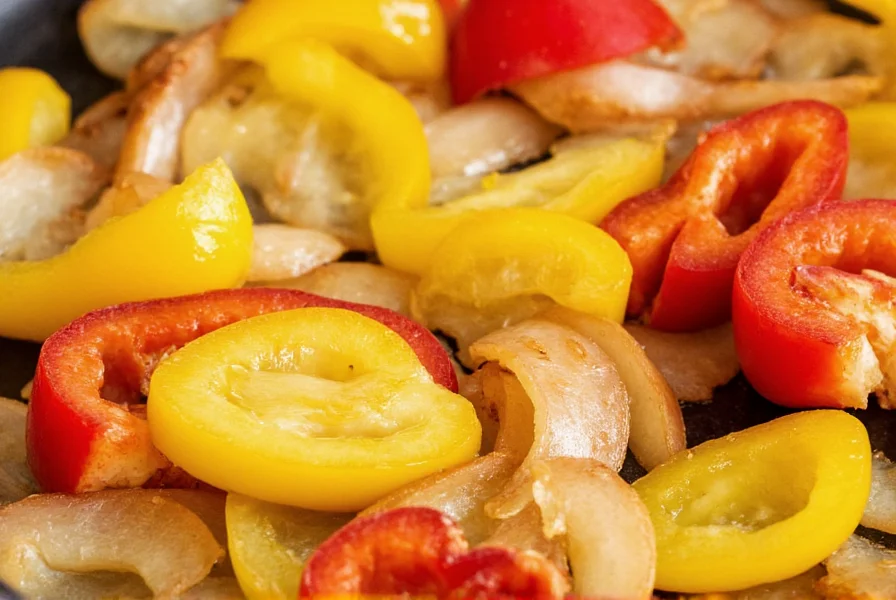Many home cooks encounter confusion when searching for 'onion pepper,' often believing it refers to a specific vegetable variety. This misconception likely stems from recipes that frequently pair onions and peppers together, creating the impression they might be a single ingredient. Let's clarify this common culinary confusion and explore how these two essential ingredients work together in cooking.
Why the 'Onion Pepper' Confusion Exists
The term 'onion pepper' doesn't describe an actual vegetable. Instead, it represents a frequent pairing in global cuisines. Chefs and home cooks regularly combine onions and various pepper types because their flavors complement each other perfectly. This consistent pairing in recipes like fajitas, stir-fries, and sofrito has led some to mistakenly believe they're referring to one ingredient.
When exploring onion and pepper cooking techniques, you'll notice these ingredients appear together across diverse culinary traditions. Spanish sofrito bases typically include both, while French mirepoix sometimes substitutes peppers for celery. This universal pairing explains why many search for 'onion pepper' when planning meals.
Understanding Onions and Peppers as Separate Ingredients
Onions (Allium cepa) belong to the Allium family, which includes garlic and leeks. They grow underground as bulbs with layered structure and contain sulfur compounds that create their characteristic pungency. Peppers (Capsicum species), however, grow above ground as fruits of the nightshade family, containing capsaicin that creates heat in chili varieties.
| Characteristic | Onions | Peppers |
|---|---|---|
| Botanical Family | Allium | Nightshade (Solanaceae) |
| Growth Habit | Underground bulb | Above ground fruit |
| Primary Compounds | Sulfur compounds | Capsaicin (in hot varieties) |
| Flavor Profile | Pungent, sweet when cooked | Earthy, ranging from sweet to fiery |
Popular Culinary Pairings of Onions and Peppers
Chefs worldwide rely on the onion and bell pepper combination as a flavor foundation. This pairing creates what's known as 'the holy trinity' in Cajun cooking (with celery), and forms the base for Spanish sofrito and Italian salsa. The natural sugars in both ingredients caramelize beautifully when cooked together, creating complex flavor compounds that enhance countless dishes.
When preparing onions and peppers for fajitas, the standard technique involves slicing both into uniform strips, then sautéing with oil over medium-high heat. The onions release sugars that help the peppers develop their characteristic roasted flavor without becoming mushy. This cooking method preserves texture contrast while allowing flavors to meld.

Substitution Options When Missing One Ingredient
Understanding substituting onion for pepper (or vice versa) requires knowing their distinct flavor contributions. If your recipe calls for both but you're missing one, consider these alternatives:
- Missing onions: Use shallots (milder flavor) or a small amount of asparagus water for savory depth
- Missing sweet peppers: Try celery plus a pinch of paprika for color and earthiness
- Missing hot peppers: Add a dash of cayenne or red pepper flakes with complementary vegetables
Remember that onion and pepper flavor chemistry works best when both ingredients are present. Substitutions alter the dish's fundamental character, so adjust expectations accordingly. For authentic regional dishes like Hungarian goulash or Mexican rajas, maintaining both ingredients proves essential to achieving traditional flavor profiles.
Proper Storage for Maximum Freshness
Storing onions and peppers separately preserves their quality. Keep whole onions in a cool, dark, well-ventilated space (never refrigerate), while peppers should go in your refrigerator's crisper drawer. Once cut, both should be stored in airtight containers in the refrigerator and used within 3-4 days.
Understanding why onions and peppers shouldn't be stored together involves their different gas emissions. Onions release ethylene gas that accelerates pepper spoilage. Separating them extends the shelf life of both ingredients, reducing food waste and saving money.

Global Dishes Featuring Onions and Peppers
From Spanish pimientos de padrón to Korean gochujang-based dishes, the onion and pepper recipe applications span global cuisines. In Middle Eastern cooking, grilled onions and peppers form the base for shakshuka, while in Southeast Asia, they combine with chilies in curry pastes.
When exploring traditional dishes with onion and pepper, note how different cultures prepare this pairing. Italian peperonata slow-cooks both ingredients until meltingly tender, while Mexican rajas features roasted poblano peppers with white onions. These preparation differences create distinct flavor experiences from the same basic ingredients.
Frequently Asked Questions
Is there actually a vegetable called onion pepper?
No, 'onion pepper' is not a real vegetable. It's a common misconception resulting from recipes that frequently pair onions and peppers together. These are two completely separate ingredients from different plant families that happen to complement each other well in cooking.
Why do so many recipes call for both onions and peppers?
Onions and peppers form a flavor foundation in many global cuisines because their natural sugars caramelize beautifully when cooked together, creating complex flavor compounds. The pungency of onions balances the earthiness of peppers, while both contribute different textures that enhance dishes. This pairing appears in culinary bases like sofrito, mirepoix variations, and the 'holy trinity' of Cajun cooking.
Can I substitute onion for pepper in recipes?
While possible in some contexts, substituting onion for pepper significantly alters the dish's flavor profile. Onions provide pungency and sweetness when cooked, while peppers contribute earthiness and varying heat levels. For sweet pepper substitutions, try celery with a pinch of paprika. For hot peppers, use a small amount of cayenne with complementary vegetables. Authentic regional dishes typically require both ingredients for proper flavor balance.
How should I store onions and peppers properly?
Store whole onions in a cool, dark, well-ventilated space (never refrigerate), while peppers should go in your refrigerator's crisper drawer. Keep them separate because onions release ethylene gas that accelerates pepper spoilage. Once cut, store both in airtight containers in the refrigerator and use within 3-4 days. Proper storage extends shelf life and maintains optimal flavor and texture for cooking.











 浙公网安备
33010002000092号
浙公网安备
33010002000092号 浙B2-20120091-4
浙B2-20120091-4